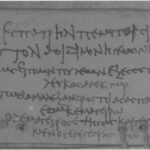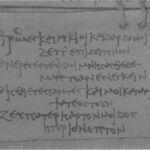| Artefact ID | 1192 |
| TM ID | TM 91945 |
| Findspot (DEChriM ID) | 12 (Ismant al-Ḫarāb) | Class | Textual |
| Material | Wood |
| Writing medium | Codex, Tablet |
| Text content | Subliterary |
| Language | Greek |
| Description | Anonymous epic parody of Homer on a wooden codex. Miniature wooden codex (dimensions: H. 8 x W. 5.5 x Th. 0.4-0.5 cm) consisting of 4 boards, of which 3 sides are blank (traces of erased writing). At the spine of the codex each board contains 4 holes and a piece of string, drawn through the holes for keeping the individual boards together, has been preserved. The boards were gessoed before carrying new writing; the text is written along the long sides, in 'landscape' fashion. It was written in hexameters, each hexameter being divided over two lines of writing, and it presents a piece of Greek poetry consisting of fifteen hexameters. According to ed. pr., the hand suggests a decently trained scribe of the middle of the 4th c. The text is possibly an original composition but could also have been a copy of a text composed one or two generations earlier. The ed. suggests that elements of the Lord's prayer were taken over into the story sketched in l. 8 ff. Not only does he note, l. 14: 'Father Zeus, give us bread', but also l. 10 where the word χρηστόν may have been used intentionally as a reminder of Χριστόν. See also Ermolaeva 2014 who quotes P.KellisCopt. I 19 about the reading of psalms in Kellis and suggests that l. 10 refers to Ps. 33:8. Writing medium and archaeological context suggests that it was a school text (see below). |
| Selection criteria | Christian terms/formulas/concepts, Biblical quote or paraphrase |
| Date from | 325 |
| Date to | 375 |
| Dating criteria | Palaeographically dated to the middle of the 4th c. (Worp 2006: 238). |
| Absolute/relative date | Relative date |
| Archaeological context | Discovered in 2002 during the course of excavations (Monash University, Melbourne) within the Temple of Tutu, in Room 2 of Shrine I in a pit north of the door, with a second codex containing three Greek division tables. Shrine I (Area D/2) is an early component of this complex two-roomed shrine on the south of the Main Temple, and it was in the outer room (2) of this structure that the codices were discovered. Both texts date from the 4th century CE and apparently come from a local school. Shrine III is a possible place of origin for the codices as it seems to have been functioning as a scriptorium, possibly coincident with the end of the temple as a place of worship. See Hope 2006. |
| Accession number | Kellis, excavations Dakleh Oasis Project, no. # D/2/46; SCA #2662. |


 Json data
Json data





